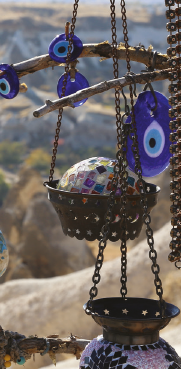The History of the Evil Eye
Did you know that circles are often seen as protective symbols? In many cultures, standing inside a circle can keep a person safe from supernatural dangers. Nazar can also do the same thing. How much do you know about it? Well, here is the history of the Evil Eye. The word nazar comes from Arabic, meaning “look” or “glance.” Of course, no culture believes that all eye contact is evil. The harmful power comes from emotions such as jealousy or greed. This meaning that the victims are people who have something precious: a child, a happy relationship, wealth or fame. The Evil Eye fixes on these good things and causes them to fall into illness, failure or other problems. When faced with this magical power, it is natural that people found a magical solution. Any visitor to Turkey will have seen the blue eye symbol on plates, pottery, jewellery, and glass. Although foreigners often call this symbol “the Evil Eye,” these are in fact made to protect you against the Evil Eye.
Some historians think the blue nazar has a connection with the sky god Tengri, which the Turks used to worship before they converted to Islam. But the Evil Eye has such a long history that it is hard to say it come from one religion. In other cultures it has different names. For example in Hebrew culture was called ayin harah, in Greek baskania and in Roman fascinatio. In modern times, Leonardo da Vinci wrote about the Evil Eye and its meaning. Istanbul-based artist Murat Bulut Aysan has created a postmodern version of Evil Eye by turning them into special pills. Just like the magical (or psychological) effect of the glass beads, Aysan says his pills give the same effect. Unfortunately you can’t buy these pills, but Aysan told a magazine that he would probably become very rich by selling them as a genuine product. So it seems that millions of people around the world still believe in a magical power that is at least 5,000 years old. Of course, there is no proof that the Evil Eye actually exists. Perhaps the Evil Eye is a way of teaching us not to be jealous of our neighbor’s success, but instead to search for happiness through our own efforts.

